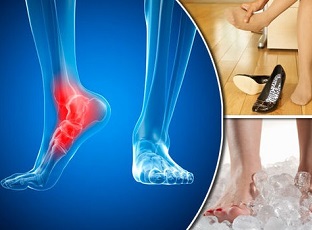- Home
- Treatment Guide
- Ice
Cold Treatment For Injuries
Written By: Chloe Wilson BSc(Hons) Physiotherapy
Reviewed By: FPE Medical Review Board

Cold treatment can be really useful after any foot and ankle injuries.
Ice can help reduce pain and swelling which can in turn speed up healing.
But did you know that if it is used incorrectly it can actually make things worse?
Here we will look at how to use ice safely and effectively to get the maximum benefit as well as the different ways you can apply it.
How Does Ice Help With Injuries?
When you use ice, you cool down the soft tissues i.e. skin, muscles, ligaments, tendons etc. This causes the blood vessels to constrict, known as vasoconstriction which reduces the blood flow to the area and therefore the bleeding into an area.

By reducing this blood flow, you reduce the amount of swelling. The main reason is that reducing swelling usually reduces pain and improves how much movement you have.
Swelling occurs when there is extra fluid which takes up space which increases the pressure in the joint or muscle and in turn limits the amount of movement eg how much you can move your foot up and down.
This fluid also contains inflammatory chemicals which irritate the surrounding nerves and tissues causing pain.
When Should You Use Ice?
Cold Treatment is most effective the first few days following an injury or surgery but can be used longer term with persistent swelling.
How Should You Apply Ice?

You should never place ice directly on your skin as it can cause an ice burn. Instead, either wrap ice in a tea towel or place it in a specially designed ice bag or you can use ice packs specially designed for treating foot injuries.
Wait 2 hours before reapplying cold therapy to allow the tissues to warm up again.
Our favourite ways of applying ice to foot and ankle injuries are:
- Ice Bag: Specially designed bags that you fill with ice. They are completely waterproof so you don't make a mess and they mold to the shape of your foot. And they're great value for money.
- Ankle Ice Wraps: These are perfect for ankle injuries as they wrap securely around the ankle providing cold therapy to the entire ankle without slipping off when you move
- Foot Ice Wrap: these wrap around the whole foot, not just the ankle, so if there is pain and swelling in the foot, these are perfect - again, they stay in place really well
- Toe Ice Packs: If you are just looking to ice your toes without chilling the rest of the foot, these are perfect e.g. after bunion surgery
How Long Should You Apply Ice For?
The optimum time to use ice therapy for is approximately 10-15 minutes. Any longer than this and you can cause an ice burn or the effect of the ice can actually be reversed – instead of blood vessels constricting they actually start to open up (vasodilatation) which increases the blood flow to the area, rather than reducing it. This is known as the Hunting Effect.
Are There Any Times You Should Not Use Ice?
Yes, in some situations it is not advisable to use cold therapy. Do not use ice if you have:
- Decreased Sensation: as you may cause yourself an ice burn.
- High Blood Pressure: the vasoconstrictive effect of ice can raise blood pressure.
- Heart Problems: If you have heart problems or decreased circulation such as peripheral vascular disease you should not use ice therapy
- Open Wound: Do not place ice directly over an open wound
- Raynaud's Disease: a rare disease affecting blood vessels
- Age: The elderly and young children should not be treated with ice therapy
Always check with your doctor before commencing cold therapy.
What Else Can Help?
Cold treatment is a great way to relieve foot pain and swelling, but it works best when combined with other treatments as well such as exercises. Visit the swollen foot treatment section for other simple ideas that may help.
It is really important to know what is causing the swelling in your foot to ensure you are getting the right treatment. If you are not sure what is causing your pain and swelling and you want some help working out what is wrong, visit the foot pain diagnosis section for loads of guidance on what's going on and how to treat it.
Related Articles
Page Last Updated: 23rd January, 2025
Next Review Due: 23rd January, 2027


